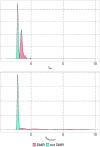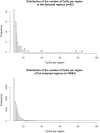Wavelet Screening identifies regions highly enriched for differentially methylated loci for orofacial clefts
- PMID: 33987535
- PMCID: PMC8092375
- DOI: 10.1093/nargab/lqab035
Wavelet Screening identifies regions highly enriched for differentially methylated loci for orofacial clefts
Abstract
DNA methylation is the most widely studied epigenetic mark in humans and plays an essential role in normal biological processes as well as in disease development. More focus has recently been placed on understanding functional aspects of methylation, prompting the development of methods to investigate the relationship between heterogeneity in methylation patterns and disease risk. However, most of these methods are limited in that they use simplified models that may rely on arbitrarily chosen parameters, they can only detect differentially methylated regions (DMRs) one at a time, or they are computationally intensive. To address these shortcomings, we present a wavelet-based method called 'Wavelet Screening' (WS) that can perform an epigenome-wide association study (EWAS) of thousands of individuals on a single CPU in only a matter of hours. By detecting multiple DMRs located near each other, WS identifies more complex patterns that can differentiate between different methylation profiles. We performed an extensive set of simulations to demonstrate the robustness and high power of WS, before applying it to a previously published EWAS dataset of orofacial clefts (OFCs). WS identified 82 associated regions containing several known genes and loci for OFCs, while other findings are novel and warrant replication in other OFCs cohorts.
© The Author(s) 2021. Published by Oxford University Press on behalf of NAR Genomics and Bioinformatics.
Figures







Similar articles
-
An epigenome-wide association study in whole blood of measures of adiposity among Ghanaians: the RODAM study.Clin Epigenetics. 2017 Sep 21;9:103. doi: 10.1186/s13148-017-0403-x. eCollection 2017. Clin Epigenetics. 2017. PMID: 28947923 Free PMC article.
-
Comparison of novel and existing methods for detecting differentially methylated regions.BMC Genet. 2018 Sep 17;19(Suppl 1):84. doi: 10.1186/s12863-018-0637-4. BMC Genet. 2018. PMID: 30255775 Free PMC article.
-
Epigenome-wide scan identifies differentially methylated regions for lung cancer using pre-diagnostic peripheral blood.Epigenetics. 2022 Apr;17(4):460-472. doi: 10.1080/15592294.2021.1923615. Epub 2021 May 19. Epigenetics. 2022. PMID: 34008478 Free PMC article.
-
DNA methylation changes in cord blood and the developmental origins of health and disease - a systematic review and replication study.BMC Genomics. 2022 Mar 19;23(1):221. doi: 10.1186/s12864-022-08451-6. BMC Genomics. 2022. PMID: 35305575 Free PMC article.
-
Genetic Factors in Nonsyndromic Orofacial Clefts.Glob Med Genet. 2020 Dec;7(4):101-108. doi: 10.1055/s-0041-1722951. Epub 2021 Feb 12. Glob Med Genet. 2020. PMID: 33693442 Free PMC article. Review.
References
-
- Martorell-Marugán J., González-Rumayor V., Carmona-Sáez P.. mCSEA: detecting subtle differentially methylated regions. Bioinformatics. 2019; 35:3257–3262. - PubMed
LinkOut - more resources
Full Text Sources
Other Literature Sources

